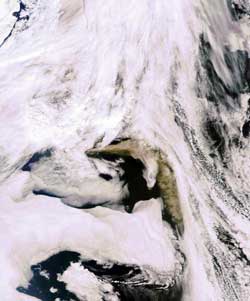Envisat captures renewed volcanic activity

New eruptions from Iceland\'s Eyjafjallajoekull volcano have produced a 1600 km-wide ash cloud over the Atlantic. The brownish plume, traveling east and then south, is clearly visible in stark contrast to white clouds framing this Envisat image from May 6, 2010. Credit: ESA<br>
The volcano began emitting steam and ash on 20 March, wreaking havoc on European aviation last month. Renewed activity earlier this week caused some flights to be suspended to and from Ireland, Northern Ireland and Scotland.
Authorities are monitoring the position and height of the ash cloud as well as the direction of prevailing Atlantic winds, which pose a problem when they blow south towards Ireland, located 1500 km southeast of the volcano.
Envisat's Medium Resolution Imaging Spectrometer (MERIS) acquired this image. To see the latest MERIS images of the ash cloud, visit our MIRAVI website. MIRAVI, which is free and requires no registration, generates images from the raw data collected by MERIS and provides them online quickly after acquisition.
Media Contact
More Information:
http://www.esa.intAll latest news from the category: Earth Sciences
Earth Sciences (also referred to as Geosciences), which deals with basic issues surrounding our planet, plays a vital role in the area of energy and raw materials supply.
Earth Sciences comprises subjects such as geology, geography, geological informatics, paleontology, mineralogy, petrography, crystallography, geophysics, geodesy, glaciology, cartography, photogrammetry, meteorology and seismology, early-warning systems, earthquake research and polar research.
Newest articles

Why getting in touch with our ‘gerbil brain’ could help machines listen better
Macquarie University researchers have debunked a 75-year-old theory about how humans determine where sounds are coming from, and it could unlock the secret to creating a next generation of more…

Attosecond core-level spectroscopy reveals real-time molecular dynamics
Chemical reactions are complex mechanisms. Many different dynamical processes are involved, affecting both the electrons and the nucleus of the present atoms. Very often the strongly coupled electron and nuclear…

Free-forming organelles help plants adapt to climate change
Scientists uncover how plants “see” shades of light, temperature. Plants’ ability to sense light and temperature, and their ability to adapt to climate change, hinges on free-forming structures in their…





















